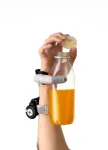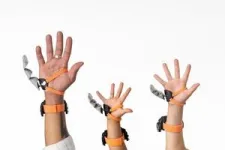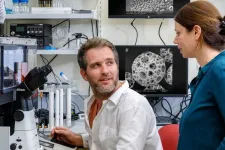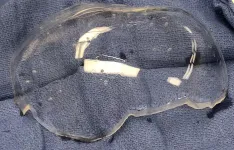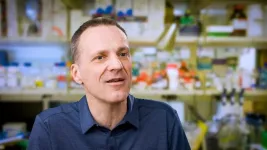(Press-News.org) Cambridge researchers have shown that members of the public have little trouble in learning very quickly how to use a third thumb – a controllable, prosthetic extra thumb – to pick up and manipulate objects.
The team tested the robotic device on a diverse range of participants, which they say is essential for ensuring new technologies are inclusive and can work for everyone.
An emerging area of future technology is motor augmentation – using motorised wearable devices such as exoskeletons or extra robotic body parts to advance our motor capabilities beyond current biological limitations.
While such devices could improve the quality of life for healthy individuals who want to enhance their productivity, the same technologies can also provide people with disabilities new ways to interact with their environment.
Professor Tamar Makin from the Medical Research Council (MRC) Cognition and Brain Sciences Unit at the University of Cambridge said: “Technology is changing our very definition of what it means to be human, with machines increasingly becoming a part of our everyday lives, and even our minds and bodies.
“These technologies open up exciting new opportunities that can benefit society, but it’s vital that we consider how they can help all people equally, especially marginalised communities who are often excluded from innovation research and development. To ensure everyone will have the opportunity to participate and benefit from these exciting advances, we need to explicitly integrate and measure inclusivity during the earliest possible stages of the research and development process.”
Dani Clode, a collaborator within Professor Makin’s lab, has developed the Third Thumb, an extra robotic thumb aimed at increasing the wearer’s range of movement, enhancing their grasping capability and expanding the carrying capacity of the hand. This allows the user to perform tasks that might be otherwise challenging or impossible to complete with one hand or to perform complex multi-handed tasks without having to coordinate with other people.
The Third Thumb is worn on the opposite side of the palm to the biological thumb and controlled by a pressure sensor placed under each big toe or foot. Pressure from the right toe pulls the Thumb across the hand, while the pressure exerted with the left toe pulls the Thumb up toward the fingers. The extent of the Thumb’s movement is proportional to the pressure applied, and releasing pressure moves it back to its original position.
In 2022, the team had the opportunity to test the Third Thumb at the annual Royal Society Summer Science Exhibition, where members of the public of all ages were able to use the device during different tasks. The results are published today in Science Robotics.
Over the course of five days, the team tested 596 participants, ranging in age from three to 96 years old and from a wide range of demographic backgrounds. Of these, only four were unable to use the Third Thumb, either because it did not fit their hand securely, or because they were unable to control it with their feet (the pressure sensors developed specifically for the exhibition were not suitable for very lightweight children).
Participants were given up to a minute to familiarise themselves with the device, during which time the team explained how to perform one of two tasks.
The first task involved picking up pegs from a pegboard one at a time with just the Third Thumb and placing them in a basket. Participants were asked to move as many pegs as possible in 60 seconds. 333 participants completed this task.
The second task involved using the Third Thumb together with the wearer’s biological hand to manipulate and move five or six different foam objects. The objects were of various shapes that required different manipulations to be used, increasing the dexterity of the task. Again, participants were asked to move as many objects as they could into the basket within a maximum of 60 seconds. 246 participants completed this task.
Almost everyone was able to use the device straightaway. 98% of participants were able to successfully manipulate objects using the Third Thumb during the first minute of use, with only 13 participants unable to perform the task.
Ability levels between participants were varied, but there were no differences in performance between genders, nor did handedness change performance – despite the Thumb always being worn on the right hand. There was no definitive evidence that people who might be considered ‘good with their hands’ – for example, they were learning to play a musical instrument, or their jobs involved manual dexterity – were any better at the tasks.
Older and younger adults had a similar level of ability when using the new technology, though further investigation just within the older adults age bracket revealed a decline in performance with increasing age. The researchers say this effect could be due to the general degradation in sensorimotor and cognitive abilities that are associated with ageing and may also reflect a generational relationship to technology.
Performance was generally poorer among younger children. Six out of the 13 participants that could not complete the task were below the age of 10 years old, and of those that did complete the task, the youngest children tended to perform worse compared to older children. But even older children (aged 12-16 years) struggled more than young adults.
Dani said: “Augmentation is about designing a new relationship with technology—creating something that extends beyond being merely a tool to becoming an extension of the body itself. Given the diversity of bodies, it's crucial that the design stage of wearable technology is as inclusive as possible. It's equally important that these devices are accessible and functional for a wide range of users. Additionally, they should be easy for people to learn and use quickly.”
Co-author Lucy Dowdall, also from the MRC Cognition and Brain Science Unit, added: “If motor augmentation – and even broader human-machine interactions – are to be successful, they’ll need to integrate seamlessly with the user’s motor and cognitive abilities. We’ll need to factor in different ages, genders, weight, lifestyles, disabilities – as well as people’s cultural, financial backgrounds, and even likes or dislikes of technology. Physical testing of large and diverse groups of individuals is essential to achieve this goal.”
There are countless examples of where a lack of inclusive design considerations has led to technological failure:
Automated speech recognition systems that convert spoken language to text have been shown to perform better listening to white voices over Black voices.
Some augmented reality technologies have been found to be less effective for users with darker skin tones.
Women face a higher health risk from car accidents, due to car seats and seatbelts being primarily designed to accommodate ‘average’ male-sized dummies during crash testing.
Hazardous power and industrial tools designed for a right-hand dominant use or grip have resulted in more accidents when operated by left-handers forced to use their non-dominant hand.
This research was funded by the European Research Council, Wellcome, the Medical Research Council and Engineering and Physical Sciences Research Council.
Reference
Clode, D & Dowdall, L et al. Assessing First Time Usability of a Hand Augmentation Device in a Large Sample of Diverse Users. Science Robotics; 29 May 2024; DOI: 10.1126/scirobotics.adk5183
END
Public have no difficulty getting to grips with an extra thumb, study finds
Researchers stress the need for inclusive testing to ensure new technologies work for everyone
2024-05-29
ELSE PRESS RELEASES FROM THIS DATE:
Breakthrough in cancer prediction with nano informatics and AI
2024-05-29
A recent study has introduced a novel method combining nano informatics and machine learning to precisely predict cancer cell behaviors, enabling the identification of cell subpopulations with distinct characteristics like drug sensitivity and metastatic potential. This research could transform cancer diagnosis and treatment, enhancing personalized medicine by facilitating rapid and accurate testing of cancer cell behaviors from patient biopsies and potentially leading to the development of new clinical tests to monitor disease progression and treatment effectiveness.
In an important advance in the fight against ...
New immunotherapy could treat cancer in the bone
2024-05-29
A new type of immunotherapy, developed by UCL researchers, has shown promising preclinical results against a bone cancer called osteosarcoma, as part of a study in mice.
Osteosarcoma is the most common bone cancer in teenagers but is still relatively rare, with around 160 new cases each year in the UK. Meanwhile, more than 150,000 people suffer from cancer that has spread to the bones.
Cancer that starts in or spreads to the bones is particularly hard to treat, meaning that it is a leading cause of cancer-related death. ...
USC researchers pioneer new brain imaging technique through clear “window” in patient’s skull
2024-05-29
In the first study of its kind, researchers from the Keck School of Medicine of USC and the California Institute of Technology (Caltech) designed and implanted a transparent window in the skull of a patient, then used functional ultrasound imaging (fUSI) to collect high-resolution brain imaging data through the window. Their preliminary findings suggest that this sensitive, non-invasive approach could open new avenues for patient monitoring and clinical research, as well as broader studies of how the brain functions.
“This is the first time anyone had applied ...
Rahimi Wins CAREER Award for Electrochemical Carbon Capture Research
2024-05-29
HOUSTON, May 29, 2024 – Mim Rahimi, an assistant professor of civil and environmental engineering at the University of Houston, has received a National Science Foundation CAREER award for his research proposal focusing on liquid-liquid interfaces for electrochemical carbon capture research.
His research proposal is “Leveraging Liquid-Liquid Interfaces for Innovative Electrochemical Carbon Capture.” It was selected for $537,719 in funding, with research running through August 2029.
“The project ...
As racial diversity and income rise, civilian injuries by police fall
2024-05-29
An analysis of civilian injuries resulting from interactions with police in Illinois found that residents of all races and ethnicities are more likely to sustain injuries if they live in economically under-resourced areas. The risk of injury decreases as communities become more racially diverse, the researchers found.
The study from the University of Illinois Chicago analyzed information on nearly 5,000 injuries caused by police that were treated in Illinois hospitals between 2016 and 2022. The researchers then compared that information with socioeconomic data from the U.S. Census on each injured person’s home ZIP code. The study is published in the ...
Mason CARES intervention reduces stress and feelings of burden of family caregivers of older adults with dementia
2024-05-29
According to the U.S. Centers for Disease Control and Prevention, 80% of those living with dementia receive informal care from family members or friends. This equates to 16 million family caregivers in the U.S. However, caring for family members with dementia is often associated with increased caregiver burden (which includes emotional, physical, and financial strain), stress, and worse physical health for the caregiver.
A recent study published in the Journal of Applied Gerontology, led by George Mason University researchers, found that a 9-week online stress ...
Fatal attraction: When endangered species try to mate with domestic relatives, both wildlife and people lose
2024-05-29
Sticks and stones aren’t enough to thwart biological attraction, but sometimes those are the only tools available to pastoralists trying to prevent wildlife from eloping with their livestock.
A new study led by Colorado State University brings awareness to both the human impacts of these encounters – ranging from economic loss to death – and conservation concerns for the wild animals that are often endangered.
Conserving threatened and endangered species is a globally recognized priority, but justice and equity for the marginalized pastoralist populations around the world who experience conflict with these species are often ...
Mass General Cancer Center researchers present key findings at ASCO
2024-05-29
Leaders from the Mass General Cancer Center, a member of the Mass General Brigham healthcare system, will present research discoveries and outcomes from clinical trials in cancer at the 2024 American Society of Clinical Oncology (ASCO) Annual Meeting, held May 31-June 4, in Chicago.
ASCO brings together leading experts in clinical oncology to share the latest breakthroughs in cancer research, science and medicine. Presentations from Mass General Cancer Center investigators include a plenary session on palliative care delivery via telehealth versus in-person for patients with advanced lung cancer. Oral presentations ...
Experimental physics leads to award-winning research
2024-05-29
NEWPORT NEWS, VA – Physicist Holly Szumila-Vance has always been curious about how the world works. Throughout her career, she has never been afraid to tackle new and tough challenges to satisfy that curiosity. In doing so, she has helped reveal new details of how the ubiquitous proton interacts with the strong force inside matter.
Now, her work to reveal the nature of matter at the U.S. Department of Energy's Thomas Jefferson National Accelerator Facility has just won special recognition: the prestigious 2024 Guido Altarelli Award – Experimental ...
Could a medicated foam make gene therapies more accessible?
2024-05-29
SEATTLE — May 29, 2024 — Foam mixed with medications is already used to treat conditions such as varicose veins, hemorrhoids, wounds on the skin and even hair loss. Now, Fred Hutch Cancer Center scientists have found that foam might also be used as a vehicle to deliver expensive gene therapies.
Published May 28 in Nature Communications, bioengineer Matthias Stephan, MD, PhD, and his Fred Hutch team report that a foaming liquid worked better than a standard liquid formulation at transferring gene therapy components to cells in laboratory studies.
“Gene therapies are the new wave of medicine, but they are extremely ...
LAST 30 PRESS RELEASES:
Why nail-biting, procrastination and other self-sabotaging behaviors are rooted in survival instincts
Regional variations in mechanical properties of porcine leptomeninges
Artificial empathy in therapy and healthcare: advancements in interpersonal interaction technologies
Why some brains switch gears more efficiently than others
UVA’s Jundong Li wins ICDM’S 2025 Tao Li Award for data mining, machine learning
UVA’s low-power, high-performance computer power player Mircea Stan earns National Academy of Inventors fellowship
Not playing by the rules: USU researcher explores filamentous algae dynamics in rivers
Do our body clocks influence our risk of dementia?
Anthropologists offer new evidence of bipedalism in long-debated fossil discovery
Safer receipt paper from wood
Dosage-sensitive genes suggest no whole-genome duplications in ancestral angiosperm
First ancient human herpesvirus genomes document their deep history with humans
Why Some Bacteria Survive Antibiotics and How to Stop Them - New study reveals that bacteria can survive antibiotic treatment through two fundamentally different “shutdown modes”
UCLA study links scar healing to dangerous placenta condition
CHANGE-seq-BE finds off-target changes in the genome from base editors
The Journal of Nuclear Medicine Ahead-of-Print Tip Sheet: January 2, 2026
Delayed or absent first dose of measles, mumps, and rubella vaccination
Trends in US preterm birth rates by household income and race and ethnicity
Study identifies potential biomarker linked to progression and brain inflammation in multiple sclerosis
Many mothers in Norway do not show up for postnatal check-ups
Researchers want to find out why quick clay is so unstable
Superradiant spins show teamwork at the quantum scale
Cleveland Clinic Research links tumor bacteria to immunotherapy resistance in head and neck cancer
First Editorial of 2026: Resisting AI slop
Joint ground- and space-based observations reveal Saturn-mass rogue planet
Inheritable genetic variant offers protection against blood cancer risk and progression
Pigs settled Pacific islands alongside early human voyagers
A Coral reef’s daily pulse reshapes microbes in surrounding waters
EAST Tokamak experiments exceed plasma density limit, offering new approach to fusion ignition
Groundbreaking discovery reveals Africa’s oldest cremation pyre and complex ritual practices
[Press-News.org] Public have no difficulty getting to grips with an extra thumb, study findsResearchers stress the need for inclusive testing to ensure new technologies work for everyone
